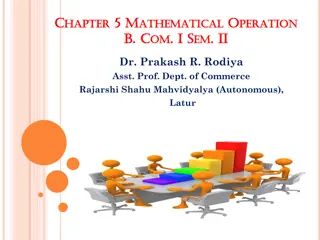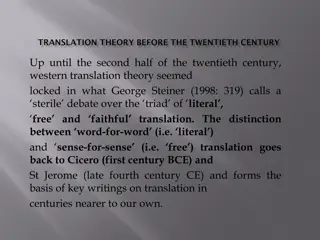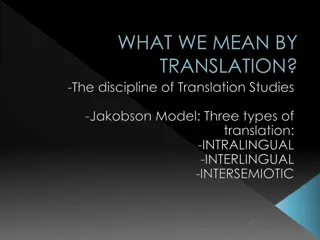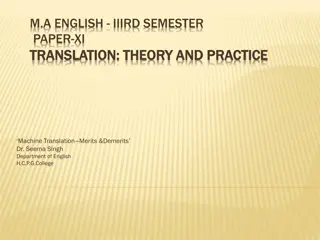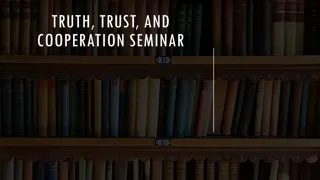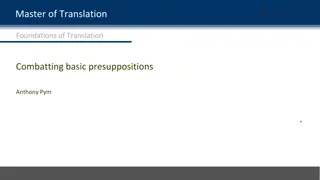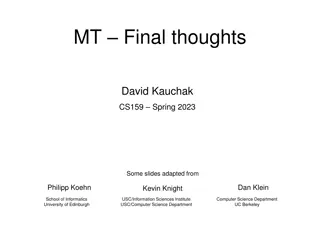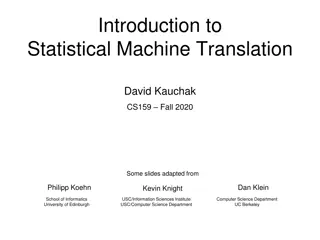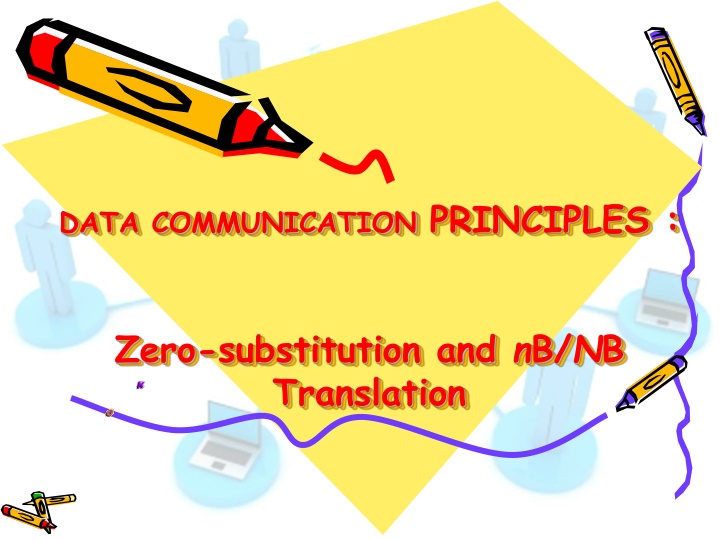
Zero-Substitution and nB/NB Translation in Data Communication Principles
Explore the concept of zero-substitution and nB/NB translation in data communication principles, where signal transitions are inserted for clocking information in NRZ and AMI schemes without requiring the bandwidth needs of Manchester coding. Learn about mechanisms like B8ZS and HDB3, which increase coding complexity but are crucial for certain communication networks.
Uploaded on | 0 Views
Download Presentation

Please find below an Image/Link to download the presentation.
The content on the website is provided AS IS for your information and personal use only. It may not be sold, licensed, or shared on other websites without obtaining consent from the author. If you encounter any issues during the download, it is possible that the publisher has removed the file from their server.
You are allowed to download the files provided on this website for personal or commercial use, subject to the condition that they are used lawfully. All files are the property of their respective owners.
The content on the website is provided AS IS for your information and personal use only. It may not be sold, licensed, or shared on other websites without obtaining consent from the author.
E N D
Presentation Transcript
DATA COMMUNICATION PRINCIPLES : Zero-substitution and nB/NB Translation
Zero-substitution and nB/NB Translation There are ways to inset signal transitions for clocking information in NRZ and AMI schemes without requiring the bandwidth needs of Manchester coding. These mechanisms increase the complexity of coding device. One of such mechanisms is called zero-substitution in which a long string of 0 s is coded such that there is a certain minimum number of pulses in the string. For example, in B8ZS (Bipolar with 8-zero substitution) eight zeros are coded together by inserting pulses in violation of the Bipolar AMI codes. The violation of AMI codes pertains to inserting pulses with the same polarity as the previous pulses occurrence. The violations are inserted in such as way as to avoid dc accumulation. Thus, if the polarity of the last pulse before the string of zeros was positive, then the eight zeros are coded as 0 0 0 + - 0 - +. Therefore, the two violations of the Bipolar AMI code help decode the correct string of zeros. If the last pulse before the occurrence of eight 0 s is negative, the polarity of the pulses representing the eight zeros is reversed making it 0 0 0 - + 0 + -. This is mostly used in USA for some long distance communications networks. Other coding schemes using zero- substitution are HDB3 (high density binary coding with 3 zeros), B3ZS and B6ZS. Figure 3- 11 shows plots of B8ZS and HDB3 encoding schemes.
The rules for HDB3 are given in Table 3-2 and for B8ZS in the the rules of encoding can be described as follows: If the polarity of the last pulse before the string of zeros is positive, then the eight zeros are coded as 0 0 0 + 0 - +. Therefore, the two violations of the Bipolar AMI code help decode the correct string of zeros. If the last pulse before the occurrence of eight 0 s is negative, the polarity of the pulses representing the eight zeros is reversed making it 0 0 0 - + 0 + -.
In another mechanism of coding with clocking information, a table is used, that has two columns. The first column consists of patterns of n bits. The second column consists of patterns of N bits. The value of N is chosen to be greater than n, so that the patterns of N bits have a specified number of both data bits. For example, in 4B/5B translation, all the patterns of the second column have at least two 1 s to guarantee clock information in a string of every 5 bits. The coder looks at the transmitting data 4 bits at a time. Then, using the table, it transmits the 5 bits pattern corresponding the 4 bits to be transmitted. In this way, 20% of the transmitted data constitutes the overhead for inserting clocking information.
REFERENCES Ahmad A. - Data Communication Principles. For Fixed and Wireless Networks Cornelius T. Leondes - Database and Data Communication Network Systems, Three-Volume Set_..-Academic Press






